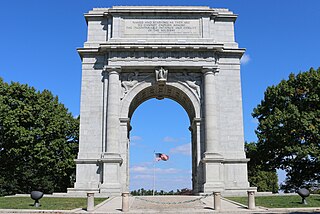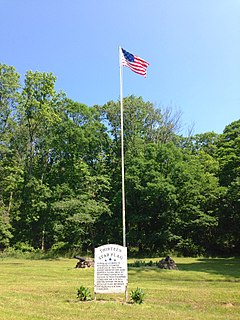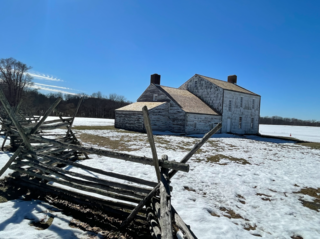The Crossroads of the American Revolution National Heritage Area is a federally designated National Heritage Area encompassing portions of fourteen counties in New Jersey that were the scene of significant actions in the American Revolutionary War in late 1776 through 1778. [1] The designated area covers the Delaware and Hudson valleys in New Jersey and the central portion of the state between the valleys where the Continental Army fought forces under British command. The National Heritage Area includes Morristown National Historical Park and sites associated with the Battle of Monmouth as well as Princeton, New Jersey, the meeting place of the Continental Congress when peace was declared in 1783. [2]
At the direction of Congress, the National Park Service studied the national importance of the Revolutionary War resources in New Jersey. In 2002 the United States Secretary of the Interior told Congress that New Jersey met all the requirements for becoming a National Heritage Area. President George W. Bush signed the legislation making XRDS an official heritage area in 2006.
The territory covered by XRDS totals 14 counties. These counties (north to south) are Passaic, Bergen, Morris, Essex, Hudson, Union, Hunterdon, Somerset, Middlesex, Mercer, Monmouth, Burlington, Camden and Gloucester.
Crossroads of the American Revolution Association (XRDS) is a not-for-profit organization created in 2002 in order to increase awareness of the American Revolution in New Jersey. The organization promotes open space, historical preservation and an enhancement of economic development in New Jersey. The Association was designated by the National Park Service as the management entity responsible for the National Heritage Area. [3]

Monmouth County is a county located on the coast of central New Jersey, in the United States within the New York metropolitan area, situated along the northern half of the Jersey Shore. As of the 2020 United States Census, Monmouth County's population was enumerated at 643,615, making it the state's fifth-most populous county, representing an increase of 13,245 (2.1%) from the 2010 Census, when the population was counted to be 630,380, in turn an increase of 15,079 from 615,301 at the 2000 Census. As of 2010, the county fell to the fifth-most populous county in the state, having been surpassed by Hudson County. Monmouth County's geographic area comprises 30% water, with a trend toward more expensive homes being constructed along the Shore, bringing rapid gentrification to the county overall.

Friedrich Wilhelm August Heinrich Ferdinand von Steuben, also referred to as Baron von Steuben, was a Prussian military officer who played a leading role in the American Revolutionary War by reforming the Continental Army into a disciplined and professional fighting force. His contributions marked a significant improvement in the performance of American troops, and he is subsequently regarded as one of the fathers of the United States Army.

Washington Crossing State Park is a 3,575-acre (14 km2) New Jersey state park that is part of Washington's Crossing, a U.S. National Historic Landmark area. It is located in the Washington Crossing and Titusville sections of Hopewell Township in Mercer County, north of Trenton along the Delaware River. The park is operated and maintained by the New Jersey Division of Parks and Forestry. It is supported by the Washington Crossing Park Association, a friends group that works to preserve, enhance, and advocate for the park.

Valley Forge National Historical Park is the site of the third winter encampment of the Continental Army during the American Revolutionary War, taking place from December 19, 1777, to June 19, 1778. The National Park Service preserves the site and interprets the history of the Valley Forge encampment. Originally Valley Forge State Park, it became a national historical park in 1976. The park contains historical buildings, recreated encampment structures, memorials, museums, and recreation facilities.

In the United States, A National Heritage Area (NHA) is a site designated by Act of Congress, intended to encourage historic preservation of the area and an appreciation of the history and heritage of the site. There are currently 55 NHAs, some of which use variations of the title, such as National Heritage Corridor.

Washington's Headquarters State Historic Site, also called Hasbrouck House, is located in Newburgh, New York overlooking the Hudson River. George Washington lived there while he was in command of the Continental Army during the final year of the American Revolutionary War; it had the longest tenure as his headquarters of any place he had used.

Joshua "Jack" Huddy was a captain in the Monmouth militia and of the privateer ship The Black Snake during the American Revolutionary War. Following his capture, Huddy was controversially executed by irregular Loyalist forces in 1782.

The Middlebrook encampment was a seasonal encampment of the Continental Army, commanded by General George Washington, during the American War for Independence near Middle Brook in Bridgewater Township, New Jersey in 1777 and again in 1778–1779. The site includes part of the ridge of the First Watchung Mountain. Its position provided a natural fortress not only protecting the Continental Army but also overlooking the plains towards New Brunswick, where the British forces were stationed in 1777. The strategic strength of the position contributed ultimately to the success of the Continental Army by lengthening the war and wearying the British forces.

Fort Lee Historic Park is located atop a bluff of the Hudson Palisades overlooking Burdett's Landing, known as Mount Constitution, in Fort Lee, New Jersey, United States. Native Americans appear to have lived in the area for thousands of years before the arrival of Europeans. The bluff was the site of George Washington's 1776 encampment opposite Fort Washington at the northern end of Manhattan. Fort Lee is named for General Charles Lee. The site is a reconstruction of the encampment including the blockhouse, battery, quarters as well as a visitors center. It is part of Palisades Interstate Park.

As the location of many major battles, New Jersey was pivotal in the American Revolution and the ultimate victory of the American colonists. This important role earned it the title of Crossroads of the American Revolution.

Pennsylvania was the site of key events and places related to the American Revolution. The state, and especially the city of Philadelphia, played a critical role in the American Revolution.

Monmouth Battlefield State Park is a 1,818-acre (7.36 km2) New Jersey state park located on the border of Manalapan and Freehold Township, in Monmouth County, New Jersey, United States. This park preserves the historical battlefield on which the American Revolutionary War's Battle of Monmouth (1778) was waged.
Israel Angell was a Continental Army officer of the American Revolutionary War.
Brandywine Battlefield Historic Site is a National Historical Landmark. The historic park is owned and operated by the Pennsylvania Historical and Museum Commission, on 52 acres (210,000 m2), near Chadds Ford, Delaware County, Pennsylvania in the United States. It is part of the site of the Battle of Brandywine fought on September 11, 1777, during the American Revolution. The Battle of Brandywine covered more than ten square miles, or 35,000 acres. However, the modern park only covers 50 acres which served primarily as the Continental encampment the two days prior to the battle. The battle was a decisive victory for the British and cleared a path directly to the rebel capital of Philadelphia. Brandywine Battlefield Park became a Pennsylvania State Park in 1949 and a National Historic Landmark in 1961.

Valley Forge functioned as the third of eight winter encampments for the Continental Army's main body, commanded by General George Washington, during the American Revolutionary War. In September 1777, Congress fled Philadelphia to escape the British capture of the city. After failing to retake Philadelphia, Washington led his 12,000-man army into winter quarters at Valley Forge, located approximately 18 miles (29 km) northwest of Philadelphia. They remained there for six months, from December 19, 1777 to June 19, 1778. At Valley Forge, the Continentals struggled to manage a disastrous supply crisis while retraining and reorganizing their units. About 1,700 to 2,000 soldiers died from disease, possibly exacerbated by malnutrition.
The Pluckemin Continental Artillery Cantonment Site in Pluckemin, New Jersey, at the southern section of Bedminster Township, New Jersey, holds historic American Revolutionary War importance as the Continental Army's artillery winter cantonment during the winter of 1778–79. It was nestled on the western side of the Second Watchung Mountain just to the North of the village of Pluckemin. The major significance of the site lies with the very different picture it yields of military organization during the Revolutionary War, although some point to it as the birthplace of the American military academy, 24 years prior to the founding of the United States Military Academy at West Point.
The Champlain Valley National Heritage Area is a federally designated National Heritage Area encompassing eleven counties in New York and Vermont surrounding Lake Champlain. The heritage area designation recognizes the area's historical and scenic significance. The region was a strategic corridor between the Hudson Valley of the United States and the Richelieu Valley of Quebec during the American Revolution in the late 18th century, and saw considerable military action during the War of 1812. During the American Civil War the valley was a part of the Underground Railroad network.

The Hudson River Valley National Heritage Area a congressionally designated area which includes the Hudson Valley in the U.S. state of New York from Saratoga Springs south almost to New York City. It is one of 55 National Heritage Areas in the United States. It provides a unified promotional framework for a select number of the area's tourist attractions, with concentration on the area's architecture, history, landscape, artistic heritage and environment, as well as interpretation of the area's historical significance in the American Revolution, the Industrial Revolution and its continuing history through the present day.

Pleasant Valley is an unincorporated community located within Marlboro Township in Monmouth County, New Jersey, United States. The area reportedly received its name from George Washington after he went through the area in 1777. The area is hilly and forested and is dotted by medium to large-sized residences. Pleasant Valley Road and Reids Hill Road are main roads that pass through the area connecting to Routes 34, 79, and 520. A large part of land which makes up Pleasant Valley was originally granted by the King of England in 1665 to the Rev. Obadiah Holmes. In 1690, the area was settled by people of Dutch heritage and the original dominant language in the area was Low Dutch.
Asher Holmes was an American politician and veteran of the American Revolution.